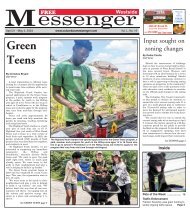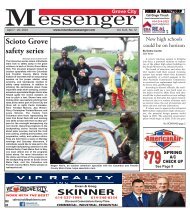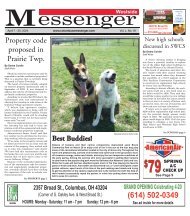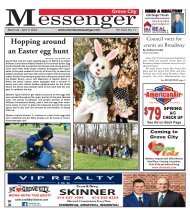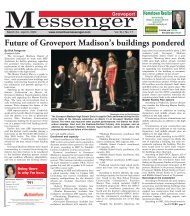Create successful ePaper yourself
Turn your PDF publications into a flip-book with our unique Google optimized e-Paper software.
www.columbusmessenger.com<br />
<strong>April</strong> 19, <strong>2020</strong> -SOUTHWEST MESSENGER - PAGE 9<br />
Laundry day was a big chore in the 1800s<br />
By Rick Palsgrove<br />
Southeast Editor<br />
We think doing laundry is a chore these<br />
days, but it’s nothing compared to what<br />
people went through to clean their clothes<br />
in the 1880s.<br />
Before the washing could even begin our<br />
ancestors had to make their own lye soap.<br />
According to workers at Metro Parks<br />
Slate Run Living Historical Farm, lye soap<br />
is made from a mixture of ashes, water,<br />
and rendered pig fat.<br />
“It’s stinky when you’re making it,” said<br />
Stephanie Reiner of Slate Run Living<br />
Historical Farm.<br />
The ashes, water, and pig fat are stirred<br />
together until they thicken into a puddinglike<br />
texture, a process that takes a while to<br />
complete. It’s important not to let the lye<br />
soap mixture touch your skin because it<br />
will cause burns.<br />
“You could ad borax to make it smoother<br />
or pumice to make the soap grittier,” said<br />
Reiner. “Making the soap is a finicky<br />
process. There are a lot of variables to consider:<br />
Is the weather hot or cold? Is it<br />
humid? You have to find a balance.”<br />
Once thickened, the soap is poured into<br />
a mold for 24 hours. It is then cut into bars<br />
in the mold and stored under the farm’s<br />
stove to cure for two to six weeks when it<br />
will then be ready to use. Soap was made<br />
regularly to make sure there was enough<br />
on hand to use when needed.<br />
“The curing process makes the lye soap<br />
usable,” said Natelle Ball of Slate Run<br />
Living Historical Farm.<br />
“Lye soap is very good at removing grass<br />
stains and blood stains,” said Reiner.<br />
Wash day<br />
Just like today, clothes would be separated<br />
into lights and darks.<br />
“Clothing in the 1880s was not color<br />
fast,” said Reiner.<br />
Clothes would be cleaned by hand using<br />
either a plunger or a corrugated washboard,<br />
rinsed in a barrel or tub, and then<br />
run through a hand operated wringer to<br />
extract water from the fabric.<br />
“The plunger works just like the agitator<br />
in a modern automatic washing<br />
machine to separate dirt from clothes,” said<br />
Pick-Up &<br />
Delivery<br />
C.M.T<br />
MOWER REPAIRS<br />
Authorized Dealers for BOB CAT Mowers<br />
6446 HARRISBURG PIKE, ORIENT, OH 43146<br />
614-875-5830<br />
www.cmtmowerrepairs.com<br />
GENERAL MAINTENANCE SERVICES<br />
Push Mowers $49.95 • Riding Tractors $159.95<br />
Zero Turn Mower $159.95<br />
Parts are additional on all units<br />
PICK-UP & DELIVERY AVAILABLE $60.00<br />
CHECK OUT THESE GREAT DEALS!!<br />
• CRZ-42........ $ 4,000.00<br />
• CRZ-48........ $ 4,200.00<br />
• CRZ-52........ $ 4,500.00<br />
• CRZ-61........ $ 4,800.00<br />
Reiner. “The washboard was good for<br />
cleaning gritty stuff from clothing.”<br />
Reiner said the plunger would be used<br />
on finer materials because it was less likely<br />
to damage clothes as using the washboard<br />
might do.<br />
“A washboard is hard on clothes,” said<br />
Reiner.<br />
Doing laundry in the 1880s was hard<br />
work.<br />
“How horrible it must have been on<br />
their hands. The skin on their hands would<br />
crack and bleed,” said Reiner of our 1880s<br />
ancestors. “They’d often use rosewater or<br />
glycerin to help soften their hands.”<br />
Clothes were hung on a clothes line to<br />
dry and, if a home did not have a clothes<br />
line, the clothes were hung on trees or<br />
bushes or laid on the grass to dry. Reiner<br />
said the really nice clothes that were made<br />
of silk or fine wool were rarely washed in<br />
this manner.<br />
Slate Run Living Historical Farm is<br />
located at 1375 State Route 674 North,<br />
near Canal Winchester. For information<br />
visit metroparks.net.<br />
• XRZ Pro RS61...... $ 8,100.00<br />
ProCat 6000 61........... $ 9,650<br />
Predator Pro 7000 72... $ 12,650<br />
0% Interest<br />
Financing up to<br />
48 months (if qualified)<br />
To advertise in a <strong>Messenger</strong> special section,<br />
contact Doug Henry at 614-272-5422.<br />
#1 in CENTRAL OHIO<br />
GILBERTS<br />
Masonry/Restoration Co.<br />
614-946-8871<br />
Lic.-Bonded-Insured<br />
32 Years in Business<br />
• Brick • Block • Stone<br />
• Cultured Stone • Stucco<br />
• Concrete • Tuck Pointing<br />
• Chimney Work<br />
• Glass Block Windows<br />
• Basement Waterproofing<br />
Free Estimates




